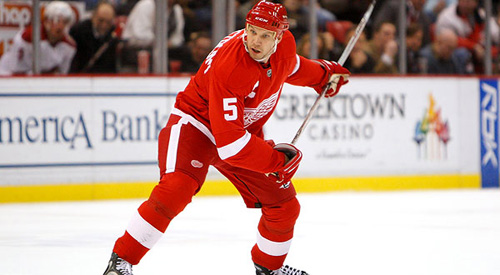
Is plus/minus a positive or negative in the NHL?
It’s not often you get rewarded in life for just showing up. But in hockey, you can find a nice little positive beside your name on the game sheet, even if you didn’t do a whole lot. Unfortunately, life on the ice is not always so kind, and often times you can play a great game and find a nasty little negative next to your name. Sometimes that’s just the nature of plus/minus.
Plus/minus was first developed by the Montreal Canadiens in the 1950s. For those of you who have been in hibernation since then, the concept is simple: A player gets a plus for being on the ice when his team scores at even-strength or short-handed; and a player gets a minus for being on the ice when the opposition scores at even-strength or short-handed. Power-play goals do not factor into the stat.
Many people have come to criticize plus/minus for a variety of reasons. One is that it is conceptualized as an individual statistic, yet often it’s highly dependent on things that an individual doesn’t control. For example, if a player hops over the boards and his teammate immediately makes a brutal giveaway leading to a goal, that’s a minus. At the end of the game the box score shows both those players as equally culpable.
Plus/minus is also highly-dependent on how good a team is and the quality of teammates a skater plays with. Three-fifths of the top-30 players in plus/minus come from the five-best teams in the league. Two-thirds of the bottom-30 comes from the bottom-five teams in the league.
[php snippet=1]
Better teams score more goals, meaning their players have more opportunities to have those pluses add up. Similarly, bad teams allow more goals, so their players are going to have a plus/minus rating that looks more like a decent golf score.
Does plus/minus really tell us anything about an individual’s ability? Or a team’s?
Zdeno Chara’s first season in Boston finished with him at minus-21. He was a plus-133 in the five seasons prior and went on to rack up a plus-113 rating in the five after. Was Chara a bad defenseman in that lone season, or were the Bruins simply a bad team?
Other times, plus/minus can just be completely random. Nicklas Lidstrom is a career plus-454, has won the Norris Trophy seven times, and is generally regarded as one of the greatest defencemen in the history of the NHL. Curiously, last season he finished the year a minus-two. Did Lidstrom suddenly forget how to play defence at age 40? Well, considering he was nominated for the Norris Trophy it might have been a glitch in the Matrix that caused the eventual Hall of Famer to dip into the red.
Despite its shortcomings, in certain cases plus/minus can tell us quite a bit about an individual. Comparing plus/minus between teammates can be extremely informative.
In 2007-08, Mike Richards led all Flyers forwards at plus-14. In stark contrast, fellow center Danny Briere was a brutal minus-22. When there is that large of a discrepancy between two players, especially on a good team (the Flyers finished sixth that season), you can say something about the relative abilities of each player. Considering Richards scored 75 points and Briere scored 72 that season, the difference was likely defensive.
Other times when a player boasts a lofty plus/minus, yet skates for a bad team, there is something to be said about that individual’s performance.
The Toronto Maple Leafs have given up the third-most goals in the league this season and have a minus-nine goal differential, yet Mikhail Grabovski is a plus-seven this season and was a plus-14 last season on a team that gave up a ton of goals and had a minus-33 goal differential.
To control how well a team plays and the quality of teammates, a stat has been developed called relative plus/minus, which is tracked at BehindTheNet.ca. This is calculated by determining a player’s plus/minus when he’s on the ice per 60 minutes then subtracting the plus/minus per 60 minutes of his teammates when he is off the ice.
Tyler Seguin, the league’s plus/minus leader, is still close to the top of the relative plus/minus leaderboard, but so too are players like Saku Koivu, Teddy Purcell and David Desharnais, none of whom are in the top-30 in regular plus/minus.
But even relative plus/minus fails to paint the entire picture. It doesn’t take into consideration the quality of competition a player matches up against, and it doesn’t take into consideration where on the ice the player usually starts.
If a player is consistently matched up against the best players and is tasked with starting the majority of his shifts in the defensive zone, a slightly negative plus/minus isn’t actually that bad relative to the situation. For example, Manny Malhotra is a minus-nine for the Canucks; second worst on the team. He was signed by the Canucks to be a defensive specialist, but based on plus/minus and the fact that the Canucks as a team have a plus-48 goal differential; it would appear as if Malhotra is a defensive liability.
However, plus/minus does not tell us that Malhotra starts close to 90 percent of his shifts in the defensive end. Provided he hasn’t just completed a shift, you can be assured that if there is a defensive zone faceoff, Malhotra will be out there. He plays hard minutes, and the fact that he is only a minus-nine is actually pretty outstanding.
Plus/minus isn’t the all encompassing stat that it was designed to be, nor is it as completely useless as some argue. But regardless of where you stand on the value of the stat, there’s one thing everyone can agree on: Bobby Orr’s single-season record of plus-124 is as safe a record as there is.
[php snippet=1]

